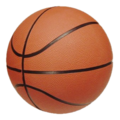Five-second closely guarded violation
A five-second closely guarded violation may be called against an offensive player with the ball when that player is guarded closely for five seconds or more, and does not pass, shoot, or dribble within that time.
Under NCAA men's rules, to be considered "closely guarded", a defender must be guarding a player who is located in the frontcourt and within six feet of the player. [2] The count applies to a player who is only holding the ball. Prior to the 2015–16 season, [3] the rule included those dribbling the ball as well. This allows for multiple closely guarded counts to occur. NCAA women's rules require the defender to be within three feet and can occur anywhere on the playing court, but only applies when the offensive player is holding the ball. [4] A count ends whenever the player with the ball gets his head and shoulders past the defender, the defender is no longer within the required distance, the same defender does not continuously closely guard the player in control of the ball, or another opponent is between the defender and the ball. [5]
High school rules mimic men's college basketball's closely guarded rule. A defender must be guarding the player in control of the ball, in the frontcourt, and must be within six feet of the player. A player may be holding or dribbling the ball. If defensive teammates switch, and both are within six feet of the player in control of the ball, the same count is continued.
Under FIBA rules, a defender must be within one meter of a player holding the ball and must be in an active guarding position. [6] This count can occur anywhere on the playing court.
In the NBA this rule is applied only in a throw in scenario. [7]
A five-second count will begin if an offensive player with the ball and not facing-up starts dribbling below the free throw line extended while being closely guarded or starts dribbling outside and then penetrates below the free throw line extended while being closely guarded. (The five-second count commences when the offensive player penetrates the free throw line extended.) After five seconds, a violation will have occurred and the offensive team will lose possession.
Penalty
The penalty for a five-second closely guarded violation is loss of ball. The opposing team will throw-in the ball from the out-of-bounds spot nearest the violation.
This page is based on this
Wikipedia article Text is available under the
CC BY-SA 4.0 license; additional terms may apply.
Images, videos and audio are available under their respective licenses.
